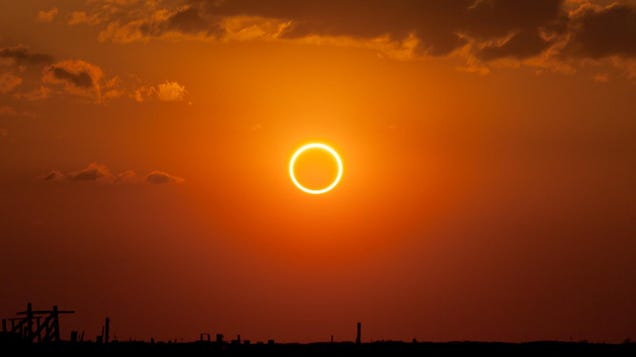The Americas are in for an astronomical treat on October 14, as an annular solar eclipse, known as the “ring of fire,” will be visible across vast swaths of the Western Hemisphere.
Google’s Pixel 8 and 8 Pro are New, and Somewhat Improved
Unlike a total solar eclipse, in which the Moon completely obscures the Sun, an annular eclipse occurs when the Moon passes between Earth and the Sun but doesn’t cover the Sun entirely, resulting in a bright ring or “annulus.”
The elliptical shape of the Moon’s orbit around Earth makes this phenomenon possible, according to NASA. During certain times when the Moon is closer to its apogee, the farthest point in its orbit, it appears smaller against the backdrop of the Sun. If an eclipse coincides with this period, the result is the “ring of fire” effect. Conversely, when the Moon is at its perigee, its closest point to Earth, and aligns just right with the Sun, a total eclipse can take place (like the one set to appear in April 2024).
For those in the U.S. and elsewhere in the Americas, the upcoming annular eclipse promises to be a celestial spectacle; all 48 contiguous states, along with Alaska, will experience a partial solar eclipse to varying degrees. This event marks the last opportunity to witness an annular eclipse in the U.S. until June 21, 2039 (even then, only Alaska will lie in the path of the 2039 event).
To fully appreciate the October 14 eclipse, viewers should locate themselves along the path of annularity. This path, where the Moon will seem to pass directly across the Sun’s center, stretches across parts of Oregon, Nevada, Arizona, New Mexico, and Texas. In the U.S., the annular solar eclipse begins in Oregon at 12:13 p.m. ET and ends in Texas at 1:03 p.m. ET. Great American Eclipse has made detailed maps and timetables available for the event.
But don’t fret if you can’t make out to the path of annularity, as varying degrees of the eclipse will be visible across much of the Western Hemisphere. Where I live in Canada, for example, I can expect a 25% obscuration of the Sun, compared to the 90% seen along the path of annularity. My plan is to capture images and possibly a timelapse of the partial eclipse using specialized filters for my two telescopes.
A clear, unobstructed view of the Sun will be ideal, but even under overcast conditions, the annular eclipse will have a noticeable effect, casting an unusual dimness during the daytime. Observers may find the day to be less bright than usual, even if clouds obscure a direct view. For those not able to view the eclipse, NASA is planning to run a live broadcast of the event.
On the date of the annular eclipse, observers near the White Sands Missile Range in New Mexico may spot bright streaks in the sky, marking the paths of three scientific rockets. These will be part of NASA’s APEP mission to study the eclipse’s impact on our upper atmosphere. The mission, led by Aroh Barjatya from Embry-Riddle Aeronautical University, aims to understand the sudden changes in the ionosphere (an atmospheric layer charged with ions and electrons) due to the rapid fluctuations in sunlight during a solar eclipse and the subsequent effects on ionospheric temperature and density.
“If you think of the ionosphere as a pond with some gentle ripples on it, the eclipse is like a motorboat that suddenly rips through the water,” Barjatya noted in NASA press release. “It creates a wake immediately underneath and behind it, and then the water level momentarily goes up as it rushes back in.”
It’s important that sky-gazers exercise caution. Even during an annular eclipse, the Sun’s powerful rays can cause severe and lasting eye damage. It’s crucial never to look directly at the Sun without special solar-viewing eyewear or employing indirect viewing methods like pinhole projectors. NASA has released safety guidelines for this event to ensure everyone can enjoy the spectacle without risk.
So on October 14, be safe, have fun, and hope for clear skies!
…. to be continued
Read the Original Article
Copyright for syndicated content belongs to the linked Source : Gizmodo – https://gizmodo.com/ring-fire-solar-eclipse-october-2023-how-to-see-1850891678
